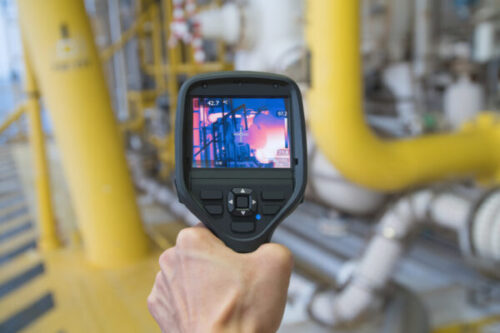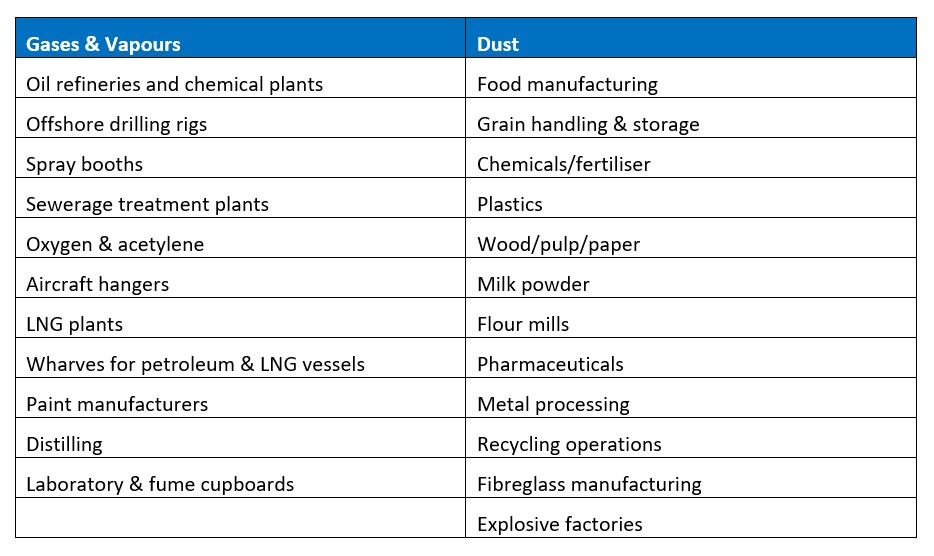The 7-Minute Rule for Roar Solutions
The 7-Minute Rule for Roar Solutions
Blog Article
An Unbiased View of Roar Solutions
Table of ContentsRoar Solutions - QuestionsThe Best Strategy To Use For Roar SolutionsExamine This Report about Roar Solutions
In order to shield installations from a prospective explosion a technique of evaluating and classifying a possibly harmful location is required. The purpose of this is to make certain the right selection and installation of tools to ultimately stop an explosion and to make certain safety and security of life.
(https://dc-washington.cataloxy.us/firms/training.roarsolution.com.au.htm)
No equipment ought to be mounted where the surface temperature level of the tools is higher than the ignition temperature level of the offered threat. Below are some common dust hazardous and their minimal ignition temperature. Coal Dust 380C 225C Polythene 420C (melts) Methyl Cellulose 420C 320C Starch 460C 435C Flour 490C 340C Sugar 490C 460C Grain Dirt 510C 300C Phenolic Material 530C > 450C Aluminium 590C > 450C PVC 700C > 450C Soot 810C 570C The chance of the threat being present in a focus high enough to create an ignition will differ from place to location.
In order to categorize this risk an installation is split right into areas of threat relying on the amount of time the hazardous exists. These locations are referred to as Zones. For gases and vapours and dusts and fibers there are three zones. Area 0 Area 20 An unsafe atmosphere is very most likely to be existing and might be existing for extended periods of time (> 1000 hours annually) and even constantly Area 1 Zone 21 A hazardous atmosphere is possible but unlikely to be present for extended periods of time (> 10 450 C [842 F] A classification of T6 means the minimal ignition temperature is > 85 C [185 F] Unsafe area electrical tools perhaps designed for usage in greater ambient temperature levels. This would certainly suggested on the rating plate e.g. EExe II C T3 Ta + 60C( This means at 60C ambient T3 will certainly not be gone beyond) T1 T1, T2, T3, T4, T5, T6 T2 T2, T3, T4, T5, T6 T3 T3, T4, T5, T6 T4 T4, T5, T6 T5 T5, T6 T6 T6 A T Course ranking of T1 implies the maximum surface temperature level produced by the tool at 40 C is 450 C. Presuming the connected T Course and Temperature ranking for the tools are appropriate for the area, you can constantly use an instrument with an extra strict Division ranking than required for the location. There isn't a clear answer to this concern. It actually does rely on the kind of tools and what fixings need to be accomplished. Tools with specific examination procedures that can't be carried out in the field in order to achieve/maintain 3rd party rating. Need to come back to the factory if it is prior to the devices's solution. Area Repair Work By Authorised Personnel: Complicated screening might not be called for nevertheless particular treatments may need to be adhered to in order for the tools to preserve its 3rd party rating. Authorised workers have to be utilized to perform the work correctly Repair service must be a like for like replacement. New component have to be thought about as a direct substitute requiring no unique screening of the tools after the repair service is total. Each item of tools with a harmful ranking ought to be assessed separately. These are laid out at a high level listed below, but also for more comprehensive details, please refer straight to the standards.
The Buzz on Roar Solutions
The tools register is a comprehensive database of devices records that consists of a minimum set of fields to determine each product's location, technological criteria, Ex-spouse category, age, and ecological information. This details is crucial for tracking and taking care of the equipment effectively within harmful areas. In comparison, for periodic or RBI sampling evaluations, the grade will certainly be a mix of In-depth and Close evaluations. The proportion of Comprehensive to Shut examinations will be identified by the Equipment Danger, which is analyzed based upon ignition danger (the likelihood of a source of ignition versus the chance of a combustible environment )and the harmful location category
( Zone 0, 1, or 2). This variation will certainly additionally influence the resourcing needs for work preparation. Once Lots are specified, you can develop tasting plans based on the sample size of each Lot, which describes the number of arbitrary tools things to be checked. To establish the called for sample dimension, two facets need to be assessed: the dimension of the Lot and the classification of assessment, which shows the level of initiative that need to be applied( minimized, normal, or boosted )to the inspection of the Great deal. By combining the category of examination with the Lot size, you can then develop the ideal being rejected criteria for an example, suggesting the allowed number of faulty items located within that example. For even more details on this procedure, please describe the Power Institute Standards. The IEC 60079 standard recommends that the maximum period between inspections should not go beyond 3 years. EEHA evaluations will additionally be conducted beyond RBI campaigns as part of set up maintenance and devices overhauls or repairs. These assessments can be credited toward the RBI example sizes within the influenced Whole lots. EEHA examinations are performed to identify mistakes in electric devices. A heavy scoring system is necessary, as a single tool might have multiple mistakes, each with differing levels of ignition threat. If the consolidated score of both inspections is much less than twice the mistake score, the Lot is deemed appropriate. If the Lot is still taken into consideration inappropriate, it has to undergo a full evaluation or validation, which might cause stricter examination protocols. Accepted Whole lot: The reasons for any faults are identified. If a typical failing mode is located, extra devices may need maintenance. Mistakes are classified by intensity( Safety and security, Stability, Housekeeping ), making certain that immediate problems are analyzed and resolved quickly to reduce any kind of influence on safety or operations. The EEHA data source ought to track and record the lifecycle of mistakes together with the corrective actions taken. Applying a robust Risk-Based Examination( RBI )approach is vital for ensuring compliance and security in managing Electric Tools in Hazardous Areas( EEHA) (Roar Training Solutions). Automated Mistake Rating and Lifecycle Monitoring: Easily manage faults and track their lifecycle to boost evaluation accuracy. The introduction of this assistance for risk-based examination further reinforces Inspectivity's setting as explanation a best-in-class option for regulatory compliance, along with for any kind of asset-centric evaluation usage case. If you have an interest in discovering a lot more, we invite you to request a presentation and find how our service can transform your EEHA management procedures.
The Ultimate Guide To Roar Solutions

In terms of eruptive threat, a dangerous location is a setting in which an eruptive ambience is present (or may be expected to be present) in amounts that require special safety measures for the building, installment and use of tools. hazardous area course. In this post we discover the obstacles encountered in the office, the danger control procedures, and the needed expertises to work safely
These compounds can, in specific problems, create explosive environments and these can have major and heartbreaking effects. Most of us are familiar with the fire triangle get rid of any kind of one of the 3 components and the fire can not occur, however what does this mean in the context of hazardous areas?
In most instances, we can do little about the degrees of oxygen in the air, but we can have considerable impact on resources of ignition, for instance electric devices. Harmful locations are recorded on the harmful location category drawing and are identified on-site by the triangular "EX LOVER" sign. Right here, amongst other vital details, zones are divided right into three types depending on the risk, the chance and period that an eruptive ambience will exist; Area 0 or 20 is deemed the most dangerous and Zone 2 or 22 is deemed the least.
Report this page